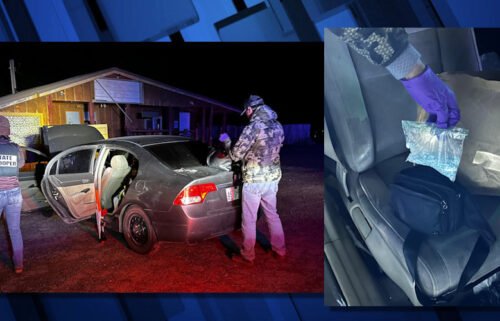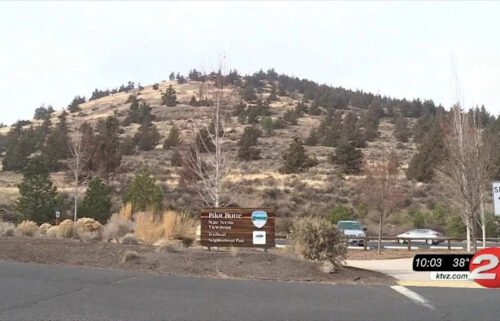Bull Springs Fire 95% contained; Level 1 evacuation notice dropped
(Update: Level 1 evacuation dropped; new info from ODFW)
Blaze now 90% contained; Level 1 'Be Ready' evacuation notice still in place
BEND, Ore. (KTVZ) -- The Bull Springs Fire that broke out Sunday northwest of Bend near Tumalo was 95% contained as of Wednesday, and the Deschutes County Sheriff's Office on Wednesday dropped Level 1 "Be Ready" evacuation notices for area residents.
Oregon Department of Forestry Public Information Officer Christie Shaw said mop-up work continued Wednesday with six engine crews, a state Department of Corrections crew and the Prineville Hotshots.
Here's a news release on the fire ODF issued Wednesday afternoon:
[Bend, Ore.] The Bull Springs Fire, west of Bend, was reported late Sunday afternoon burning in slash, Ponderosa pine, juniper and brush. This wind-driven fire grew quickly, burning 211 acres before fire fighters were able to stop the spread.
Two outbuildings were destroyed by the fire, and nearly 200 residences were placed in a Level 3 (GO) evacuation Sunday evening.
Coordination between Bend Fire Department, Deschutes County Sheriff’s Office, Oregon Department of Forestry, and federal resources from Central Oregon Fire Management Service were the key to catching this fire Sunday evening and protecting structures and homes in the fire area.
Aided by dozers from Taylor Northwest, fire crews were able to get line around the fire’s perimeter and focus on any spot fires outside the fireline.
Firefighters have continued to work in the fire area, monitoring for spot fires, and extinguishing heat and flames within the perimeter. Additional crews from the Department of Corrections and the US Forest Service Prineville Hotshots have aided in this work. As of Wednesday afternoon, the fire is estimated to be 95% contained.
Fire managers anticipate completing the mop-up work on Thursday with five engines and the Department of Corrections crew. The fire will continue to be monitored and checked in the coming weeks to ensure the fire is out. The Deschutes County Sheriff's Office lifted all evacuation orders Wednesday morning.
The cause of the fire has been determined to be a rekindled debris burn. Heat can hold in burn piles and even under soil for many weeks with no visible smoke. With limited recent moisture in Central Oregon vegetation and wildland fuels are very dry, making them susceptible to ignition and rapid fire spread, especially on windy days. Please check burn piles and burn areas from any debris burning completed this winter or spring to ensure there is no residual heat or fire.
Below are some tips to reduce the risk of a fire getting out of control.
- Check weather forecasts. Avoid burning on windy days or when wind is forecast to be erratic or increasing.
- Check with local fire department and county restrictions to be certain burning is allowed and what restrictions should be followed.
- Never leave a fire unattended. Be certain the fire is completely out prior to leaving.
- Have a water source and shovel available while burning.
- Keep debris piles small. Add material gradually as the pile burns down.
- Ensure burned piles are cold prior to adding new material for future burning.
- Contact 911 immediately if the fire gets out of control.
For additional information on ODF’s Central Oregon District, including contact information and unit offices, please visit www.ODFcentraloregon.com.
According to the ODF, the fire that burned more than 200 acres and prompted evacuations and area road closures was caused by a rekindled debris burn, fanned by winds gusting to 50 mph.
A stump burn that rekindled also sparked a smaller fire in Deschutes River Woods south of Bend Sunday afternoon that also prompted evacuations and road closures.
But how does ODF investigate and determine the cause of a wildfire?
ODF Wildland Fire Supervisor Kyle Nairns says finding the origin spot is key.
"Protecting where they think the origin is is important," Nairns said. "If there's anyone else in the area that can give us information, we use that as well."
Nairns says they'll use magnifying glasses, high-definition cameras and even metal detectors to search for any evidence.
"From there, we work with either those folks on scene or we bring in other investigators to assist," Nairns said. "They'll process this scene by looking at the burn indicators."
He says burn indicators on rocks, sticks, logs and trees can help determine the direction the fire took.
And in some cases, the ODF will utilize LiDAR technology, or light detection and ranging through airplanes.
This remote sensing method uses light in the form of a pulsed laser to measure distance, and that information can be used to generate 3-D maps.
Nairns says those maps can get within millimeters of accuracy, to help create a full picture.
But in the case of smaller fires like Bull Springs, they can employ more traditional techniques to determine the origin and cause.




